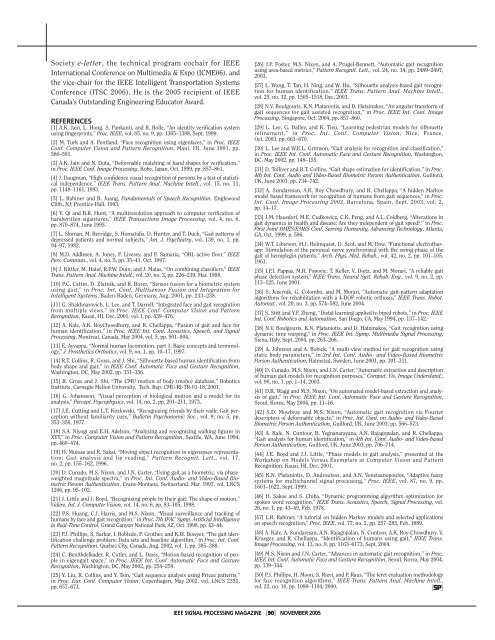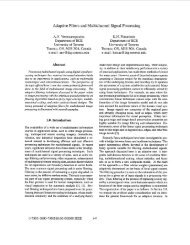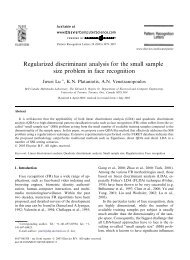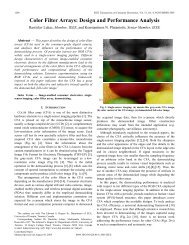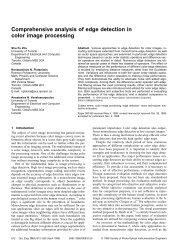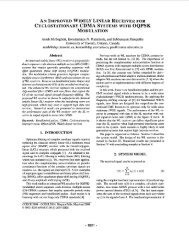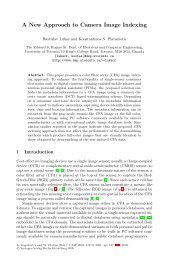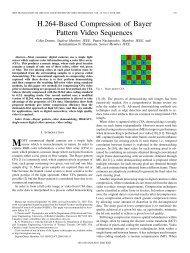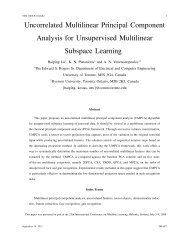Gait Recognition: Gait Recognition: - ABES Engineering College
Gait Recognition: Gait Recognition: - ABES Engineering College
Gait Recognition: Gait Recognition: - ABES Engineering College
Create successful ePaper yourself
Turn your PDF publications into a flip-book with our unique Google optimized e-Paper software.
Society e-letter, the technical program cochair for IEEEInternational Conference on Multimedia & Expo (ICME06), andthe vice-chair for the IEEE Intelligent Transportation SystemsConference (ITSC 2006). He is the 2005 recipient of IEEECanada’s Outstanding <strong>Engineering</strong> Educator Award.REFERENCES[1] A.K. Jain, L. Hong, S. Pankanti, and R. Bolle, “An identity verification systemusing fingerprints,” Proc. IEEE, vol. 85, no. 9, pp. 1365–1388, Sept. 1999.[2] M. Turk and A. Pentland, “Face recognition using eigenfaces,” in Proc. IEEEConf. Computer Vision and Pattern <strong>Recognition</strong>, Maui, HI, June 1991, pp.586–591.[3] A.K. Jain and N. Duta, “Deformable matching of hand shapes for verification,”in Proc. IEEE Conf. Image Processing, Kobe, Japan, Oct. 1999, pp. 857–861.[4] J. Daugman, “High confidence visual recognition of persons by a test of statisticalindependence,” IEEE Trans. Pattern Anal. Machine Intell., vol. 15, no. 11,pp. 1148–1161, 1993.[5] L. Rabiner and B. Juang, Fundamentals of Speech <strong>Recognition</strong>. EnglewoodCliffs, NJ: Prentice-Hall, 1993.[6] Y. Qi and B.R. Hunt, “A multiresolution approach to computer verification ofhandwritten sigantures,” IEEE Transactions Image Processing, vol. 4, no. 6,pp. 870–874, June 1995.[7] L. Sloman, M. Berridge, S. Homatidis, D. Hunter, and T. Duck, “<strong>Gait</strong> patterns ofdepressed patients and normal subjects,” Am. J. Psychiatry, vol. 139, no. 1, pp.94–97, 1982.[8] M.D. Addlesee, A. Jones, F. Livesey, and F. Samaria, “ORL active floor,” IEEEPers. Commun., vol. 4, no. 5, pp. 35–41, Oct. 1997.[9] J. Kittler, M. Hatef, R.P.W. Duin, and J. Matas, “On combining classifiers,” IEEETrans. Pattern Anal. Machine Intell., vol. 20, no. 3, pp. 226–239, Mar. 1998.[10] P.C. Cattin, D. Zlatnik, and R. Borer, “Sensor fusion for a biometric systemusing gait,” in Proc. Int. Conf. Multisensor Fusion and Integration forIntelligent Systems, Baden-Baden, Germany, Aug. 2001, pp. 233–238.[11] G. Shakhnarovich, L. Lee, and T. Darrell, “Integrated face and gait recognitionfrom multiple views,” in Proc. IEEE Conf. Computer Vision and Pattern<strong>Recognition</strong>, Kauai, HI, Dec. 2001, vol. I, pp. 439–476.[12] A. Kale, A.K. RoyChowdhury, and R. Chellappa, “Fusion of gait and face forhuman identification,” in Proc. IEEE Int. Conf. Acoustics, Speech, and SignalProcessing, Montreal, Canada, May 2004, vol. 5, pp. 901–904.[13] E. Ayyappa, “Normal human locomotion, part 1: Basic concepts and terminology,”J. Prosthetics Orthotics, vol. 9, no. 1, pp. 10–17, 1997.[14] R.T. Collins, R. Gross, and J. Shi, “Silhouette-based human identification frombody shape and gait,” in IEEE Conf. Automatic Face and Gesture <strong>Recognition</strong>,Washington, DC, May 2002, pp. 351–356.[15] R. Gross and J. Shi, “The CMU motion of body (mobo) database,” RoboticsInstitute, Carnegie Mellon University, Tech. Rep. CMU-RI-TR-01-18, 2001.[16] G. Johansson, “Visual perception of biological motion and a model for itsanalysis,” Percept. Psycophysics, vol. 14, no. 2, pp. 201–211, 1973.[17] J.E. Cutting and L.T. Kozlowski, “Recognizing friends by their walk: <strong>Gait</strong> perceptionwithout familiarity cues,” Bulletin Psychonomic Soc., vol. 9, no. 5, pp.353–356, 1977.[18] S.A. Niyogi and E.H. Adelson, “Analyzing and recognizing walking figures inXYT,” in Proc. Computer Vision and Pattern <strong>Recognition</strong>, Seattle, WA, June 1994,pp. 469–474.[19] H. Murase and R. Sakai, “Moving object recognition in eigenspace representation:<strong>Gait</strong> analysis and lip reading,” Pattern Recognit. Lett., vol. 17,no. 2, pp. 155–162, 1996.[20] D. Cunado, M.S. Nixon, and J.N. Carter, “Using gait as a biometric, via phaseweightedmagnitude spectra,” in Proc. Int. Conf. Audio- and Video-Based BiometricPerson Authentication, Crans-Montana, Switzerland, Mar. 1997, vol. LNCS1206, pp. 95–102.[21] J. Little and J. Boyd, “Recognizing people by their gait: The shape of motion,”Videre, Int. J. Computer Vision, vol. 14, no. 6, pp. 83–105, 1998.[22] P.S. Huang, C.J. Harris, and M.S. Nixon, “Visual surveillance and tracking ofhumans by face and gait recognition,” in Proc. 7th IFAC Symp. Artificial Intelligencein Real-Time Control, Grand Ganyon National Park, AZ, Oct. 1998, pp. 43–44.[23] P.J. Phillips, S. Sarkar, I. Robledo, P. Grother, and K.W. Bowyer, “The gait identificationchallenge problem: Data sets and baseline algorithm,” in Proc. Int. Conf.Pattern <strong>Recognition</strong>, Quebec City, Canada, Aug. 2002, vol. 1, pp. 385–388.[24] C. BenAbdelkader, R. Cutler, and L. Davis, “Motion-based recognition of peoplein eigengait space,” in Proc. IEEE Int. Conf. Automatic Face and Gesture<strong>Recognition</strong>, Washington, DC, May 2002, pp. 254–259.[25] Y. Liu, R. Collins, and Y. Tsin, “<strong>Gait</strong> sequence analysis using Frieze patterns,”in Proc. Eur. Conf. Computer Vision, Copenhagen, May 2002, vol. LNCS 2351,pp. 657–671.[26] J.P. Foster, M.S. Nixon, and A. Prugel-Bennett, “Automatic gait recognitionusing area-based metrics,” Pattern Recognit. Lett., vol. 24, no. 14, pp. 2489–2497,2003.[27] L. Wang, T. Tan, H. Ning, and W. Hu, “Silhouette analysis-based gait recognitionfor human identification,” IEEE Trans. Pattern Anal. Machine Intell.,vol. 25, no. 12, pp. 1505–1518, Dec. 2003.[28] N.V. Boulgouris, K.N. Plataniotis, and D. Hatzinakos, “An angular transform ofgait sequences for gait assisted recognition,” in Proc. IEEE Int. Conf. ImageProcessing, Singapore, Oct. 2004, pp. 857–860.[29] L. Lee, G. Dalley, and K. Tieu, “Learning pedestrian models for silhouetterefinement,” in Proc. Int. Conf. Computer Vision, Nice, France,Oct. 2003, pp. 663–670.[30] L. Lee and W.E.L. Grimson, “<strong>Gait</strong> analysis for recognition and classification,”in Proc. IEEE Int. Conf. Automatic Face and Gesture <strong>Recognition</strong>, Washington,DC, May 2002, pp. 148–155.[31] D. Tolliver and R.T. Collins, “<strong>Gait</strong> shape estimation for identification,” in Proc.4th Int. Conf. Audio and Video-Based Biometric Person Authentication, Guilford,UK, June 2003, pp. 734–742.[32] A. Sundaresan, A.K. Roy Chowdhury, and R. Chellappa, “A hidden Markovmodel based framework for recognition of humans from gait sequences,” in Proc.Int. Conf. Image Processing 2003, Barcelona, Spain, Sept. 2003, vol. 2,pp. 14–17.[33] J.M. Hausdorf, M.E. Cudkowicz, C.K. Peng, and A.L. Coldberg, “Alterations ingait dynamics in health and disease: Are they independent of gait speed?,” in Proc.First Joint BMES/EMBS Conf. Serving Humanity, Advancing Technology, Atlanta,GA, Oct. 1999, p. 586.[34] W.T. Liberson, H.J. Holmquest, D. Scot, and M. Dow, “Functional electrotherapy:Stimulation of the peroneal nerve synchronized with the swing phase of thegait of hemiplegin patients,” Arch. Phys. Med. Rehab., vol. 42, no. 2, pp. 101–105,1961.[35] I.P.I. Pappas, M.R. Popovic, T. Keller, V. Dietz, and M. Morari, “A reliable gaitphase detection system,” IEEE Trans. Neural Syst. Rehab. Eng., vol. 9, no. 2, pp.113–125, June 2001.[36] S. Jezernik, G. Colombo, and M. Morari, “Automatic gait-pattern adaptationalgorithms for rehabilitation with a 4-DOF robotic orthosis,” IEEE Trans. Robot.Automat., vol. 20, no. 3, pp. 574–582, June 2004.[37] S. Stitt and Y.F. Zheng, “Distal learning applied to biped robots,” in Proc. IEEEInt. Conf. Robotics and Automation, San Diego, CA, May 1994, pp. 137–142.[38] N.V. Boulgouris, K.N. Plataniotis, and D. Hatzinakos, “<strong>Gait</strong> recognition usingdynamic time warping,” in Proc. IEEE Int. Symp. Multimedia Signal Processing,Siena, Italy, Sept. 2004, pp. 263–266.[39] A. Johnson and A. Bobick, “A multi-view method for gait recognition usingstatic body parameters,” in 3rd Int. Conf. Audio- and Video-Based BiometricPerson Authentication, Halmstad, Sweden, June 2001, pp. 301–311.[40] D. Cunado, M.S. Nixon, and J.N. Carter, “Automatic extraction and descriptionof human gait models for recognition purposes,” Comput. Vis. Image Understand.,vol. 90, no. 1, pp. 1–14, 2003.[41] D.K. Wagg and M.S. Nixon, “On automated model-based extraction and analysisof gait,” in Proc. IEEE Int. Conf. Automatic Face and Gesture <strong>Recognition</strong>,Seoul, Korea, May 2004, pp. 11–16.[42] S.D. Mowbray and M.S. Nixon, “Automatic gait recognition via Fourierdescriptors of deformable objects,” in Proc. Int. Conf. on Audio- and Video-BasedBiometric Person Authentication, Guilford, UK, June 2003, pp. 566–573.[43] A. Kale, N. Cuntoor, B. Yegnanarayana, A.N. Rajagopalan, and R. Chellappa,“<strong>Gait</strong> analysis for human identification,” in 4th Int. Conf. Audio- and Video-basedPerson Authentication, Guilford, UK, June 2003, pp. 706–714.[44] J.E. Boyd and J.J. Little, “Phase models in gait analysis,” presented at theWorkshop on Models Versus Exemplars at Computer Vision and Pattern<strong>Recognition</strong>, Kauai, HI, Dec. 2001.[45] K.N. Plataniotis, D. Androutsos, and A.N. Venetsanopoulos, “Adaptive fuzzysystems for multichannel signal processing,” Proc. IEEE, vol. 87, no. 9, pp.1601–1622, Sept. 1999.[46] H. Sakoe and S. Chiba, “Dynamic programming algorithm optimization forspoken word recognition,” IEEE Trans. Acoustics, Speech, Signal Processing, vol.26, no. 1, pp. 43–49, Feb. 1978.[47] L.R. Rabiner, “A tutorial on hidden Markov models and selected applicationson speech recognition,” Proc. IEEE, vol. 77, no. 2, pp. 257–285, Feb. 1989.[48] A. Kale, A. Sundaresan, A.N. Rajagopalan, N. Cuntoor, A.K. Roy-Chowdhury, V.Krueger, and R. Chellappa, “Identification of humans using gait,” IEEE Trans.Image Processing, vol. 13, no. 9, pp. 1163–6173, Sept. 2004.[49] M.S. Nixon and J.N. Carter, “Advances in automatic gait recognition,” in Proc.IEEE Int. Conf. Automatic Face and Gesture <strong>Recognition</strong>, Seoul, Korea, May 2004,pp. 139–144.[50] P.J. Phillips, H. Moon, S. Rizvi, and P. Raus, “The feret evaluation methodologyfor face recognition algorithms,” IEEE Trans. Pattern Anal. Machine Intell.,vol. 22, no. 10, pp. 1090–1104, 2000.[SP]IEEE SIGNAL PROCESSING MAGAZINE [90] NOVEMBER 2005


